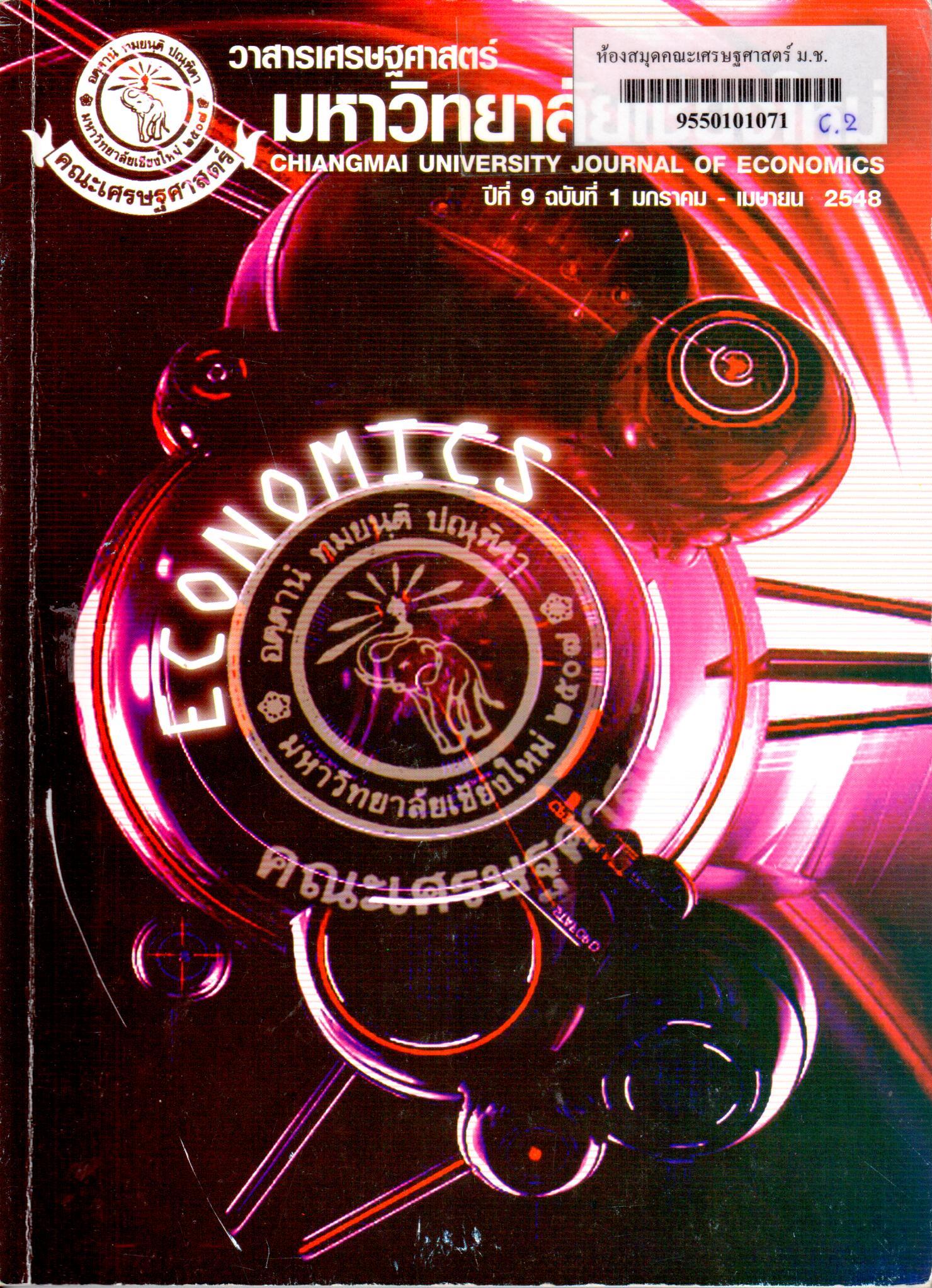การประเมินความเต็มใจจ่ายของผู้ดูแลผู้ป่วย สำหรับโครงการส่งเสริมความรู้แก่ผู้ดูแลผู้ป่วยที่เป็นโรคอันเนื่องมาจากการสูบบุหรี่ กรณีศึกษาในจังหวัดเชียงใหม่
Abstract
บทคัดย่อ
การศึกษานี้มีจุดมุ่งหมายเพื่อประเมินความเต็มใจจ่ายของผู้ดูแลผู้ป่วยและปัจจัยที่มีผลกระทบต่อความเต็มใจจ่ายของผู้ดูแลผู้ป่วยที่เป็นโรคอันเนื่องมาจากการสูบบุหรี่ สำหรับโครงการส่งเสริมความรู้ (knowledge promotion program : KPP) ของภาครัฐในรูปแบบการจ่ายเงินภาษีรายได้และค่าประกันสุขภาพ โดยใช้ข้อมูลปฐมภูมิที่ได้จากการสัมภาษณ์ผู้ดูแลผู้ป่วยจำนวน 300 ราย ที่นำญาติมารักษาโรคต่างๆ ที่เนื่องมาจากการสูบบุหรี่ คือ กลุ่มโรคมะเร็ง กลุ่มโรคระบบทางเดินหายใจ และกลุ่มโรคหัวใจและหลอดเลือดในฐานะเป็นผู้ป่วยในของโรงพยาบาลรัฐและเอกชนในจังหวัดเชียงใหม่ ด้วยการสุ่มตัวอย่างแบบเจาะจง
การประเมินมูลค่าความเต็มใจจ่ายโดยอาศัยวิธีการคอนทินเจนท์ (contingent valuation method : CVM) ในรูปแบบการพยายามลดความไม่สอดคล้องกันให้น้อยที่สุด (dissonance minimizing format : DM) ทั้งนี้เพื่อลดความอ้วนอย่างจากการต่อเพียงใช่ (yea-saying) และการคัดค้านวิธีจ่ายเงิน (protest answers) โดยแยกผู้สนับสนุนโครงการออกไปตามการยอมรับและการค้าขายวิธีจ่ายเงิน ภายใต้แนวคิดการสร้างอรรถประโยชน์ทางอ้อมของ Hanemann (1984) และทำการประมาณมูลค่าความเต็มใจจ่ายโดยวิธี Logistic Regression โดยอาศัยวิธีการประมาณแบบ Maximum Likelihood Estimations (MLE) ศูนย์การศึกษาปัจจัยที่มีผลกระทบต่อความเต็มใจจ่ายได้ประมาณค่าโดยวิธีการถดถอยเชิงเส้นภายใต้วิธีการประมาณค่าแบบวิธีกำลังสองสมบูรณ์น้อยที่สุด
ผลการศึกษาทางเลือกการจ่ายเงินสนับสนุนโครงการ ชี้ให้เห็นว่า ผู้ดูแลผู้ป่วยส่วนใหญ่สนับสนุนโครงการแต่คัดค้านวิธีการจ่ายเงินโดยยินดีจ่ายเงินเมื่อเชื่อได้ว่ารัฐบาลมีทุนดำเนินการไม่เพียงพอ โดยมูลค่าความเต็มใจจ่ายในรูปภาษีรายได้เฉลี่ยต่อปีสำหรับโครงการส่งเสริมความรู้มีค่าเท่ากับ 815.07 บาท และมีค่ามัธยฐานของมูลค่าความเต็มใจจ่ายเท่ากับ 728.33 บาท ส่วนมูลค่าความเต็มใจจ่ายค่าประกันสุขภาพเฉลี่ยต่อเดือน มีค่าเท่ากับ 287.47 บาท และมีค่ามัธยฐานของข้อมูลค่าความเต็มใจจ่ายเท่ากับ 226.03 บาทต่อเดือน
ผลการศึกษาปัจจัยที่มีผลกระทบต่อความเต็มใจจ่ายของผู้ดูแลผู้ป่วยพบว่า ปัจจัยที่มีผลกระทบเชิงบวกได้แก่ รายได้ครอบครัว ระดับการศึกษา การมีญาติผู้ป่วยในกลุ่มโรคที่เกี่ยวข้องกับการสูบบุหรี่ 3 กลุ่มโรค คือ กลุ่มโรคมะเร็งกลุ่ม โรคระบบทางเดินหายใจ และกลุ่มโรคหัวใจและหลอดเลือด ระยะเวลาการป่วยของผู้ป่วย ผลกระทบที่เกิดจากการเจ็บป่วยที่มีต่อคนรอบข้างในครอบครัว และระดับความยากลำบากในการดูแลผู้ป่วย ส่วนปัจจัยที่มีผลกระทบเชิงลบได้แก่ ระยะเวลาการเลิกสูบบุหรี่ของผู้ป่วย และความคิดเห็นว่าความเจ็บป่วยของผู้ป่วยมีความเกี่ยวข้องกับการสูบบุหรี่ จากมูลค่าความเต็มใจจ่ายที่ได้จากการศึกษาชี้ให้เห็นว่าโครงการส่งเสริมความรู้แก่ผู้ดูแลผู้ป่วยของภาครัฐมีความเป็นไปได้ในการที่จะดำเนินการในอนาคต โดยต้องมีหน่วยงานด้านสาธารณสุขของรัฐเป็นผู้รับผิดชอบโดยคำนึงถึงปัจจัย ที่มีผลกระทบต่อความเต็มใจจ่ายของผู้ดูแลผู้ป่วยเป็นหลัก เพื่อให้การดำเนินโครงการส่งเสริมความรู้ประสบผลสำเร็จและบรรลุวัตถุประสงค์สอดคล้องกับกลุ่มเป้าหมายที่สนับสนุนโครงการโครงการส่งเสริมความรู้แก่ผู้ดูแลผู้ป่วยควรดำเนินการบนพื้นฐานความพอใจของชุมชนที่นำไปสู่การลดภาระการดูแลผู้ป่วยในสังคมโดยรวมต่อไป
Abstract
The study aims to estimate of the Willingness to Pay (WTP) for a Knowledge Promotion on Program (KPP) for Smoking Related Illness of patient’s Caregivers and tpassess the factors affecting WTP of such KPP in term of annual income tax and monthly health insurance. The primary data was collected through the purposive sampling technique and face-to-face interview of 300 patient’s caregiver for those who have their relatives infected by smoking related diseases, namely Malignant Neoplasm, Respiratory and Heart and Vascular diseases, and admitted as an inpatient in the government and private hospitals in Chiang Mai province.
The Dissonance-Minimizing format (DM) in Contingent Valuation Method is used to estimate for WTP. This study allows the respondents to express their support for the KPP regardless of the payment vehicle to avoid of yea-saying and the protest answer bias under the Hanemann’s concept of Utility Difference Model (1984). The estimated value of WTP is obtained by the Logistic Regression Model though the Maximum Likelihood estimation method. In addition, the factors affecting WTP are estimated by Linear Regression Model though the Ordinary Least Square method.
The study results of the alternative payment to support the KPP indicated that most of patient’s caregivers are chosen to protest otherwise support for the KPP and willing to pay whenever the government does not have enough public funds to support such program. The Mean of WTP for KPP through income taxes equal to 815.07 baht per year and the Median of WTP is about 728.33 baht per year. Meanwhile, the mean of WTP paying through health insurance is about 287.47 baht per month and the Median of WTP is about 226.03 baht per month.
The research results of factors affecting WTP found that the WTP of patient’s caregivers are positive influenced by their household income, education status, relative patient’s status for those who infected with Malignant Neoplasm, Respiratory and Heart and Vascular disease group, relapsed time impacts and burden of caregivers. Meanwhile, the WTP are negative influenced by the quitted times duration and for those patient who has opinion that their illnesses are related with smoking.
According to the above mentioned WTP figures, there is possible to operate such KPP in the future and will be responsible of the public health organization under the consideration of various factors effecting WTP. In order to succeed and meet with objectives of the KPP, meanwhile it is still consisted with each target group that support and willing to pay for such program. The KPP should be implemented and operated under the community’s preferences which will lead to the reduction of caregiver burden for a society as a whole.
Downloads
Issue
Section
License
All opinions and contents in the CMJE are the responsibility of the author(s). Chiang Mai University Journal of Economics reserves the copyright for all published materials. Papers may not be reproduced in any form without the written permission from Chiang Mai University Journal of Economics.
ข้อคิดเห็นที่ปรากฏและแสดงในเนื้อหาบทความต่างๆในวารสารเศรษฐศาสตร์มหาวิทยาลัยเชียงใหม่ ถือเป็นความเห็นและความรับผิดชอบโดยตรงของผู้เขียนบทความนั้นๆ มิใช่เป็นความเห็นและความรับผิดชอบใดๆของวารสารเศรษฐศาสตร์ มหาวิทยาลัยเชียงใหม่
บทความ เนื้อหา และข้อมูล ฯลฯ ในวารสารเศรษฐศาสตร์มหาวิทยาลัยเชียงใหม่ ถือเป็นลิขสิทธิ์เฉพาะของคณะเศรษฐศาสตร์มหาวิทยาลัยเชียงใหม่ หากบุคคลหรือหน่วยงานใดต้องการนำทั้งหมดหรือส่วนหนึ่งส่วนใดไปเผยแพร่ต่อหรือเพื่อกระทำการใดๆ จะต้องได้รับอนุญาตเป็นลายลักษณ์อักษร จากวารสารเศรษฐศาสตร์ มหาวิทยาลัยเชียงใหม่






